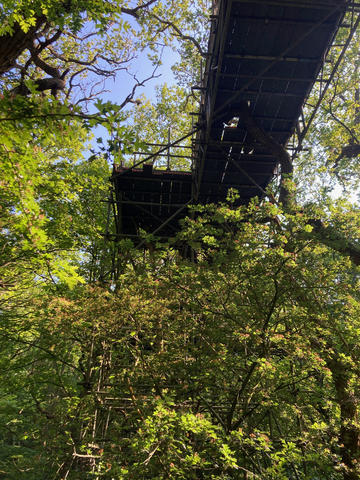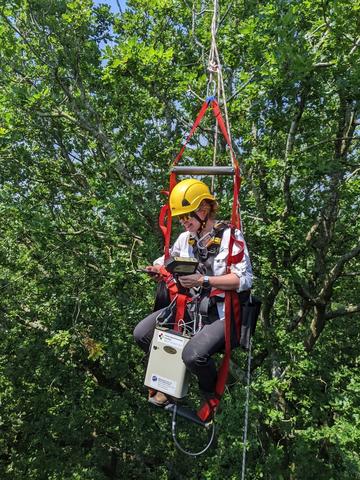A new study has revealed that Oxford’s Wytham Woods has significant ozone pollution – a finding with consequences for the entire ecosystem.

A canopy walkway in the trees in Wytham Woods
Ozone (O3) is best known for forming a protective layer around the planet, absorbing UV radiation from the sun. However, this ‘ozone layer’ is tens of kilometres above the ground – nearer the surface, ozone is a toxic pollutant. Ground level ozone has a complex mix of precursors, some created by burning fossil fuels, and forms when nitrogen oxides (NOx), methane, and volatile organic compounds (VOCs) react in sunlight. NOx and VOC emissions circulate globally so reducing O3 pollution goes beyond each individual country’s borders.
O3 is much less stable than O2, and as a result causes oxidative damage to both humans and the environment. It stunts tree growth and reduces resilience to changing conditions, but we don’t yet know the scale of ozone damage to forests. Understanding this damage is one piece of the puzzle for the problematic pollutant, which is already at dangerously high levels across the world and expected to continue rising.
Comparing high-resolution leaf reflectance at Wytham Woods in Oxford and the Birmingham Institute of Forest Research’s (BIFoR) FACE woodland, researchers accurately predicted ozone exposure in mature oak trees from leaf reflectance alone. The trees in Wytham Woods were exposed to much higher ozone levels than those at the BIFoR FACE woodland, with the results revealing changes in leaf structure and pigments caused by ozone stress. Lead researcher Anna Jones said:
“Leaf reflectance could be affected by other factors like light or soil nutrients, but the differences we saw were strongly linked to O3 concentration changes within each site as well as between the two. The specific changes in leaf reflectance were similar to what we saw in young oak trees experimentally exposed to high O3 in our previous study. This makes a clear case for ozone being the defining factor.”

Anna conducting research while suspended in the canopy
Their work pioneers the use of an existing technique for the purpose of measuring ozone damage in trees– hyperspectral monitoring, which detects the reflectance of light across many wavelengths from ultraviolet and visible light to infrared. This unlocks potential for monitoring ozone damage at much larger scales than have been possible before, across entire forests by remote sensing.
One finding was increased green reflectance in higher ozone levels areas. Green reflectance is partly influenced by chlorophyll. Chlorophyll is the key pigment which allows plants to generate energy from light, and which converts carbon dioxide into oxygen in the process. Chlorophyll content decreases during ozone stress; this has a clear impact on plants’ ability to store carbon, and lower energy production has repercussions for the rest of the food web which relies on plants.
Other pigments such as anthocyanins and carotenes can also influence green reflectance, but these increase during ozone stress – as antioxidants, they detoxify O3. The sensitivity of different species to ozone partially depends on this ability – but it is costly and impacts how much carbon plants can store long-term. Forests are crucial carbon sinks, making their health an essential natural part of climate change mitigation. Anna added:
“Forests’ ability to store carbon is a hot topic, and there is a huge amount of interest in planting trees to offset carbon emissions. However, almost all replanting initiatives fail to take ozone pollution into account. For trees to help us in the fight against climate change, we need to understand where forests are being damaged and plan carefully to avoid polluted areas or use resistant species. Ozone has dropped off the radar of many politicians and scientists, but it’s one of the most damaging pollutants to ecosystems and needs our attention.
In Wytham Woods, we are missing a crucial part of the ecosystem by not continuously monitoring ozone exposure – it’s a missing piece in the puzzle to our much-studied ‘living laboratory’. Ozone damage changes the phenology of trees (e.g. when leaves drop in autumn), affects their sensitivity to drought and disease, and changes the allocation of resources to things like roots and seeds.”
To read more about this research, published in Ecological Indicators, visit: https://doi.org/10.1016/j.ecolind.2025.113263